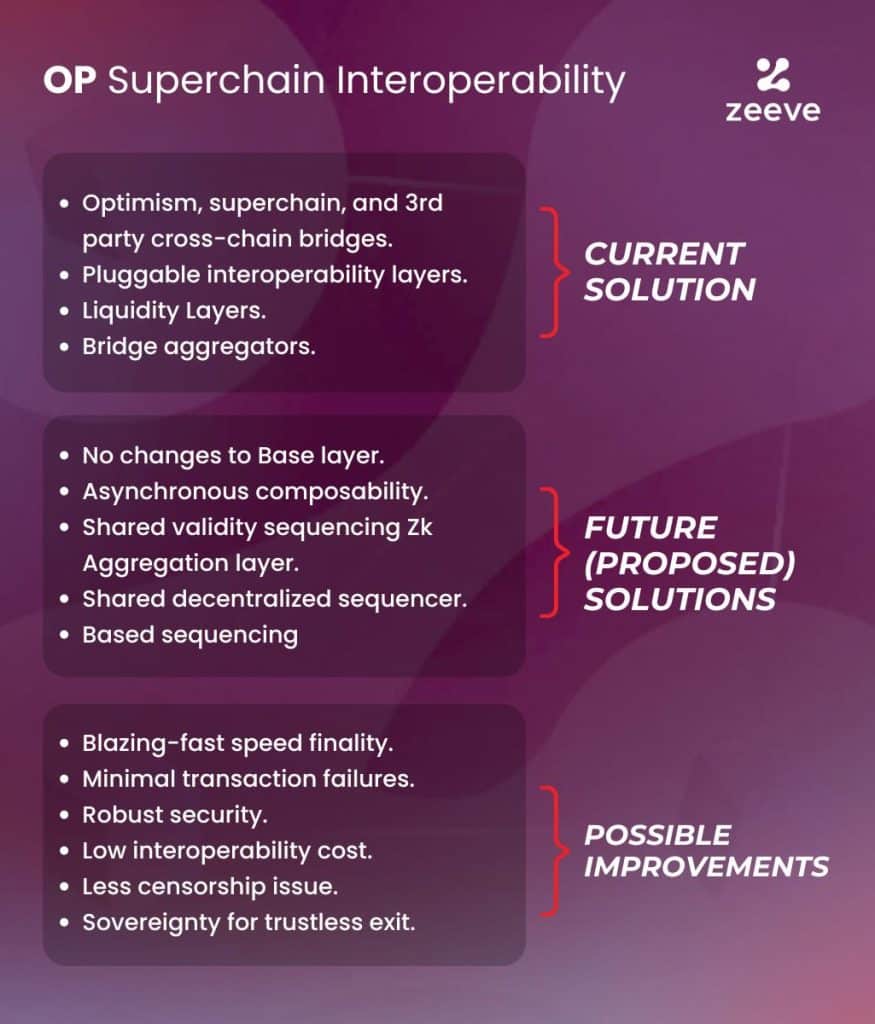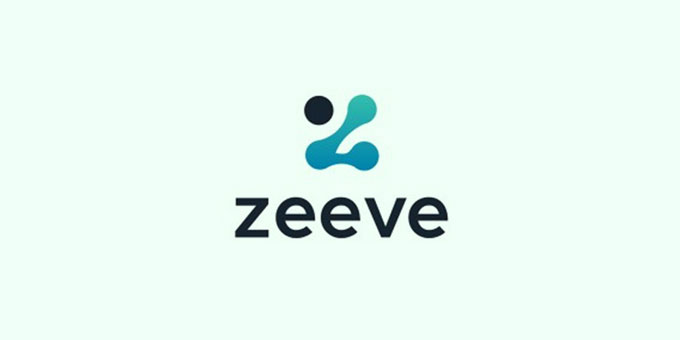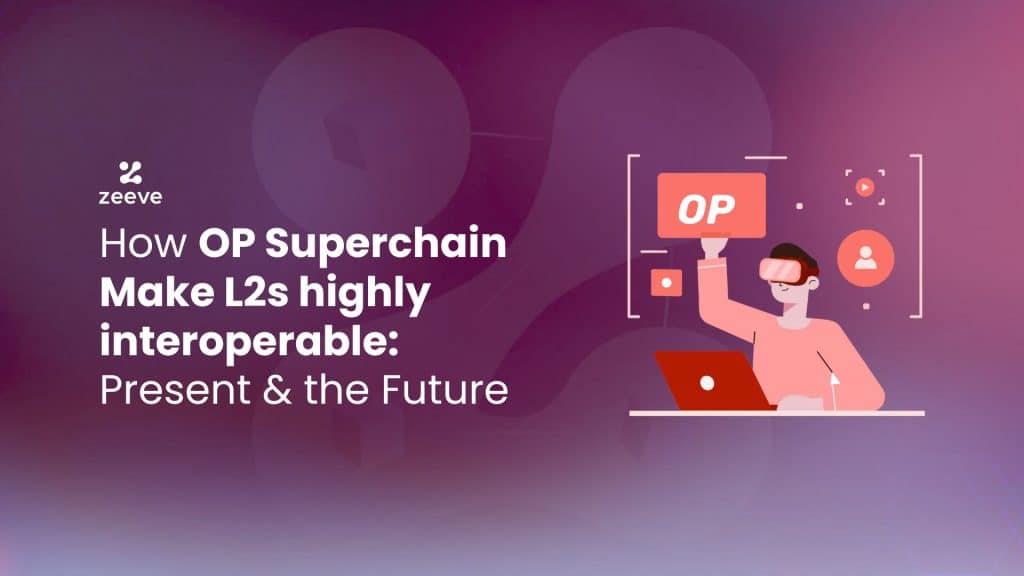OP Superchain ecosystem is growing tremendously. The reason for this can be battle-tested security, super scaling, and modularity. But, cross-L2s interoperability is said to be the most significant factor that has encouraged big names like Base, Zora, Mantle Network, and Ancient8 to build their standalone OP rollup chains.
Considering this, our article digs into the core concept of OP Superchain Interoperability, highlighting its current solutions and the vision superchain has created for the future. Basically, it aims to give you an idea about how OP chains operate right now in terms of interoperability and what solutions they can adopt for a sustainable future.
The critical need of interoperability across OP Stack Superchains
As we know, each OP chain has the end goal to satisfy the specific requirements of both dApp builders and the end users. For example, a dApp user may look for seamless onboarding, high transaction speed, low fees, zero transaction failures, and a simple yet powerful wallet infrastructure. Talking about developers, they seek easy access to liquidity, governance, and cross-chain transfers. The requirements for all these stakeholders can be catered through enabling unparalleled OP Superchain interoperability. Here’s why end-to-end interoperability is critical for OP superchain:
- Seamless token bridging: The capability of OP chains being able to bridge assets cross-chain enables web3 builders to create sustainable DeFi solution on top of OP stack. Plus, ease of bridging avoids the hassle of incorporating burn & mint standards.
- Inter-chain state verification: L2 builders seek the ability to read and verify chain’s state easily on different chains without going through the prolonged process of initiating messages and its verification.
- Atomic transactions: Atomic transaction is a critical component for dApps, especially the DeFi apps; which consist of atomic inclusion and atomic execution. With inclusion, dApps can get the ability to burn/mint-like features. Meanwhile, atomic execution enables the seamless moving of assets like flash loans across various chains, allowing users to hop on L2s that offer lower interest.
Superchain’s current and future interoperability state:
Optimism is working on achieving native interoperability between OP Superchains. However, OP Chains still supports end-to-end interoperability for best user experience, ease of use, and unified liquidity across sovereign chains.
As discussed, we’ll first discuss what strategies OP Superchain implements at the moment and what different ideas superchain envision to adopt in future. Also, we will quickly discuss the tradeoff of all these interoperability solutions. Let’s start!
Current solutions
#1: Cross-chain bridges: Optimism and 3rd party bridges
The idea of superchain is to introduce a network of chains that can share a common communication layer, decentralized governance, upgrades, and asset bridging–everything built on top of OP Stack. Knowing that all these are achievable through interoperability, Optimism offers an advanced cross-chain bridge that acts as a foundation to move tokens from/to any OP stack chain using the standard canonical bridge. Also, OP superchain support a range of 3rd party bridges to enable bridging between superchains and non-OP stack/Ethereum chains.
#2: Pluggable Interoperability Protocols: Axelar, LayerZero, Wormhole, and more
Popular interoperability protocols/layers such as Axelar, LayerZero, Wormhole, Hyperlane, and Socket are supported on OP superchains. These are essentially interoperability stacks that allow dApps to engage in cross-chain activities beyond bridging capabilities, such as sending arbitrary messages or utilizing contract logic. Projects building L2s with OP Stack can choose an interoperability layer matching their requirements and simply plug it with minimal effort or upfront cost. The selection can be mainly made based on critical parameters like permissionless deployment, the ability to detect malicious transactions or communication speed.
#3: Liquidity Layers: Catalyst, Orderly Network
Superchain allows OP chains to utilize Catalyst or Orderly Network as their modular liquidity layer. Both of these liquidity layers enable sovereign OP chains to seamlessly transfer value/assets cross-chain and tap into liquidity of Layer2s builders to allow seamless liquidity sharing across standalone chains. Further, these solutions claim to eradicate bridging challenges like fragmented liquidity, complex UX, or security breaches. Note that Catalyst and Orderly Network are already an integral part of the superchain ecosystem as Catalyst is deployed on Base and Orderly is built using OP Stack itself. Now, these are enabling interoperability across all the modular OP chains.
#4: Bridge aggregators: Jumper, Bungee, etc.
Bridge aggregators like Jumper and Bungee are innovative multi-chain bridging and swap solutions that assist OP superchains to achieve greater interoperability with any OP Stack L2s and various EVM-compatible chains. These are like one-stop solutions to buy, exchange, or swap tokens across superchains and also pay gas fees without hassle.
As you might already know, there are certain challenges associated with the superchain’s existing interoperability solutions. For example, bridges can cause delays in asset/message transfer due to ‘a challenge period, liquidity fragmentation, complex UX, and security vulnerabilities like false deposits or private key compromises. Similarly, pluggable interoperability layers can cause centralization issues as they are operated through some trusted entities. Also, cost here can be high due to inclusion of Merkle proofs. As for liquidity engines, there can be issues like liquidity imbalance and price slippages.
Therefore, Superchains has visioned for novel interoperability solutions that aims to unlock native interoperability for OP chains and Optimism dApps. Let’s dive into those ideas and also highlight their possible tradeoffs.
Solutions for future:
There are different approaches in Superchain’s interoperability roadmap through which OP Superchain aims to battle against lack of interoperability and thus facilitate seamless communication between OP chains. Let’s discuss them:
#1: No changes to Base layer
The approach of allowing no changes to the base layer is somewhat similar to the current space of Ethereum/EVM interoperability state. This will require OP chains to add an abstraction layer on top of the dApps’ monolithic experience, enabling them to use multi-message aggregation (MMA) tools that supports trust-minimized asset bridging across siloed chains. Initially, this solution may offer an average cross-chain experience for users, but the user experience, security, and cost will improve due to constant innovation and increasing competition. However, this solution comes with certain tradeoffs, such as expensive cross-chain interaction, lack of trust, cross-chain MEV, and MEV censorship. These tradeoffs might not be a trouble on developers’ end, but end dApp users will be highly impacted as they seek interoperability and security the most.
#2: Asynchronous composability
Asynchronous composability refers to the approach of OP Superchains leveraging IBC protocol to offer endless interoperability across OP chains. This solution is an improvised alternative to the previous solution because it offers secure cross-chain bridging without involving MMA solutions or 3rd party bridges. Hence, it allows for a cheaper and more standardized way of bridging for users. Superchain builders can retain sovereignty in this interoperability design and they can even have a near-monolithic experience if asynchronous composability is combined with proper intents. Simply put, Asynchronous composability makes verification of cross-messaging easier for OP superchains, allowing them to confirm and mark blocks as fast on any corresponding chain. The possible tradeoff here can be due to the interdependency of rollups. If one rollup is compromised, it will impact all the adjacent rollups. Also, cross-chain MEV will be a trouble in Asynchronous composability similar to the first option.
#3: Shared validity sequencing
Shared validity sequencing is an interoperability solution proposed by Umbra Research for superchain. This refers to a shared sequencer architecture supporting cross-chain interaction between OP chains. Following are the three main components upholding this sequencing design, including:
- A mechanism for shared sequencer to support cross-chain interactions.
- A block building algorithm in shared sequencer to manage cross-chain transactions while also respecting atomic transactions and conditional execution terms.
- Shared fraud proofs for all the involved superchains to ensure guarantee for cross-chain transactions.
Using above components, shared validity sequencing outlines two different systems; the atomic burn and mint method and generalization of this same method to offer cross-chain experience beyond burn & mint. The first structure is based on system contracts, block building, and shared fraud proofs where burn on rollup A will only happen if mint on rollup B succeeds.
Now, for generalization, this method can be easily modified to allow for passing of arbitrary messages and conditional transaction execution across OP rollups. Here, a cross-rollup action is invoked when all the triggered calls or none of them succeed.
The challenge with this approach is the requirement for a shared sequencer to run full nodes for all the rollup it has done sequencing. Similarly, rollups also need to run nodes for cross-verification purposes. Doing this can be complex as well as expensive. Additionally, if an invalid state happens on a rollup, it will impact all its associated rollups.
#4: Zk Aggregation layer
The Zk Aggregation layer represents an interoperability concept similar to Polygon’s zk aggregation layer which requires the Superchain stack to transition over Zk-powered rollups. The Optimism ecosystem already has recognized the pace of zero-knowledge advancement and its rapid adoption, therefore now superchain is seeking to add zk-rollups in its stack soon. This will tackle the challenges of synchronous composability because verification and inclusion can be done seamlessly using zk-proofs. Also, ZK technology tackles the centralization issue of shared validity sequencing along with enabling fast finality.
However, the cost will slightly increase for both dApp developers and users as there will be an aggregation layer sitting between the superchain-based rollup and the settlement layer. There is another concern for existing OP rollups who may struggle to meet the expectations of being permissionless which is a must to leverage the aggregation layer.
#5: Shared decentralized sequencer
Shared sequencer is one of the highly feasible solutions that match most of the interoperability requirements on OP superchain with almost zero trade offs. Having such sequencers means that superchains can offer a fully secure atomic inclusion & exclusion through crypto-economic guarantees and meanwhile keeping the decentralization intact. Shared sequencers also contribute to better liveliness, security, and extremely fast finality in rollups via pre-confirmations. However, note that pre-confirmation requires re-staking which comes with its own set of challenges and cost add on because users need to pay for atomic execution guarantees.
#6: Based sequencing
Based sequencing or Layer-1 sequencing has emerged as a great solution to align OP rollups more towards Layer1 Ethereum, unlock higher decentralization while also seamlessly interoperability across them. One additional benefit of based sequencing is the liveliness and censorship inheritance from Layer1; the Layer1 proposers can also serve as proposers on the based sequencing network.
Again, the cost here can be high due to superchain’s need to operate with all the other superchains, independent L2s outside the superchain ecosystem, as well as Ethereum itself. However, the final cost depends upon which all layers a user actually interacts with. Plus, this end-to-end interaction approach also leads to fast finality and finality guarantees to improve user experience on superchains. Learn more about based sequencing here.

Launch your modular OP Stack Powered Chain with Zeeve RaaS
From our whole discussion around OP Superchain interoperability, it is evident that superchain will soon offer native interoperability through a best-suited approach. However, we strongly believe that OP stack rollups will still have the choice to leverage native interoperability or existing solutions. Knowing this, Zeeve Rollups-as-a-service platform is offering a comprehensive OP Stack-specific stack for enterprises and web3 projects to launch modular OP rollup chains offering end-to-end interoperability, unified liquidity, and robust security. From one-click sandbox tool to decentralized shared sequencers, Alt DA layers, and MPC wallets– Zeeve RaaS has 40+ integration add ons and the list is expanding constantly. So, if you are planning to launch an OP stack superchain, Zeeve Raas will help you to save significant cost and accelerate time-to-market. Connect with our web3 expert to discuss your project requirements or get a quote instantly.






















